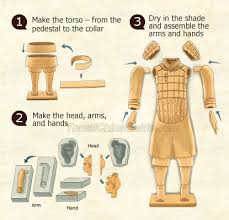
What are the Terracotta Army figures made of?
The Making of the Terracotta Army
Historians speculate that thousands, or even tens of thousands, of artisans were involved in the creation of the Terracotta Army. Each figure was meticulously handcrafted without the use of molds, although eight basic face shapes were used as a starting point for further individualization. These faces were then combined with other body parts in an assembly line fashion, resulting in the unique appearances and postures of the figures seen today.
The creation of the Terracotta Army followed the military structure of the Qin army, encompassing various ranks of officers, different military branches, chariots, and horses. After shaping the figures, artisans painted and fired them in kilns. Real weapons and armor were added to complete the lifelike representations. Finally, the figures were strategically arranged according to Qin military formations, meticulously placed according to their rank and military branch.
Different Perspectives on the Army’s Purpose
The remarkable resemblance of the Terracotta Army to the actual Qin army has led some to believe it is an accurate replica. However, an alternative viewpoint suggests that the army's significance lies more in its symbolic and ceremonial value rather than its representation of a real-world military force. Nevertheless, the Terracotta Army undoubtedly provides valuable insights into the military prowess of the Qin dynasty, enabling military scholars to delve deeper into understanding the might of "Strong Qin."
Moreover, since the Terracotta Army figures were modeled after real Qin soldiers, researchers believe studying their facial features could offer insights into the customs and lifestyles of the Qin dynasty. The inscription "Made by Lü Buwei, Chancellor of the State" found on many weapons further solidifies the dating of the Terracotta Army to the reign of Qin Shi Huang and confirms their connection to his mausoleum complex.
Weaponry and Armor of the Terracotta Army
Analysis of the Terracotta Army figures and their weaponry reveals the Qin army's bowmen were equipped with a variety of arrows, indicating their preparedness for diverse combat situations. Interestingly, the figures are depicted without helmets. Experts offer different explanations for this: some believe it was to project an image of fearlessness and intimidate enemies on the battlefield. Others attribute it to the limited use of swords by the army at the time.
Since the primary weapons of the infantry were "stabbing weapons" like halberds and swords, mostly made of bronze, their brittleness made slashing attacks impractical. As these weapons were primarily used for thrusting attacks targeting the chest and abdomen, the Terracotta Army figures are depicted wearing chest armor. With a lower probability of head injuries in combat, ordinary Qin soldiers might not have worn helmets. This absence of helmets was potentially not unique to the Qin army, as evidence suggests it might have been a common practice in the succeeding Han dynasty as well, where infantry soldiers typically wore caps instead of helmets and shoulder protectors.
Another plausible explanation for the lack of helmets is that they would have obscured the soldiers' faces. This contradicts the artistic choice of crafting individualized faces instead of mass-producing identical figures. Therefore, the absence of helmets on the Terracotta Army figures appears to be a deliberate artistic decision.
Debunking the Myth of Chromium Coating
For four decades, a prevailing theory suggested that the Qin people had developed an advanced chromium-based coating technology to prevent metal corrosion in their weapons 2,000 years ago. However, recent research in 2019 debunked this theory, revealing that the traces of chromium were merely contamination from nearby lacquer, not a deliberate preservation method. Instead, the study proposes that the weapons' remarkable preservation is likely due to the slightly alkaline pH level and the fine texture of the surrounding soil.
Q&A
- Q: What are the main materials used to make the Terracotta Army figures?
A: The Terracotta Army figures are primarily made of terracotta, a type of earthenware clay. They were then painted with pigments after firing.
- Q: Why don’t the Terracotta Army figures wear helmets?
A: There are several theories, including the possibility that helmets were not common in the Qin army, that their absence was meant to project an image of fearlessness, or that it was an artistic choice to showcase the individualized faces.
- Q: How were the weapons of the Terracotta Army preserved for so long?
A: Contrary to previous beliefs, the weapons were not treated with chromium. The soil’s alkaline pH level and fine texture are believed to be the main factors contributing to their preservation.